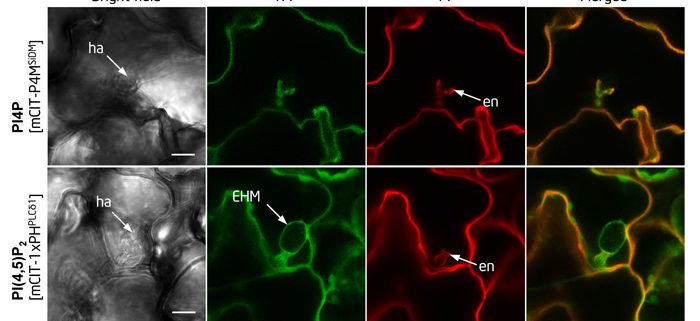Plant Pathogens Recruit PI(4,5)P2 to the Interfacial Membrane for Disease Development
Qin et al. show that PI(4,5)P2 functions as a susceptibility factor for plant disease. Plant Cell https://doi.org/10.1105/tpc.19.00970
By Li Qin and Yangdou Wei. Department of Biology, University of Saskatchewan, Canada
Background: Biotrophic plant pathogens such as powdery mildews and rusts require living cells to feed on and they form a specialized feeding structure called the haustorium inside host cells for nutrient uptake. The haustorium is enveloped by a highly modified extrahaustorial membrane (EHM) that separates the haustorium from the cytoplasm of its host cell. Our knowledge about the biogenesis of the EHM is limited, although some models hypothesize that the EHM originates from the host plasma membrane (PM). In the Arabidopsis–powdery mildew interaction, all plant PM-localized proteins tested appear to be absent at the EHM, and the specific identity and composition of the EHM remain a mystery. Uncovering the chemical composition of EHM can help us understand the mechanisms underlying the biogenesis and function of the haustorium.
Question: Membrane identities are acquired by the combined presence of specific proteins and lipids. We tested whether the EHM has a distinct lipid profile from the PM by examining the distribution of phosphoinositide species that are partitioned in the membrane systems, thereby contributing to the membrane identity and function.
Findings: We show that among two major PM phosphoinositide species in Arabidopsis, only PI(4,5)P2, but not PI4P, selectively targets to the EHM. The PI(4,5)P2 content increases at the powdery mildew infection site, and the accumulation of PI(4,5)P2 at the EHM occurs through an ectopic transport from the PM pool dependent on actin cytoskeleton-mediated cellular trafficking. Depletion of PI(4,5)P2 by mutating its biosynthetic enzyme genes prevents disease development of host plants against various plant pathogens. Disease resistance in the mutant is not accompanied by cell death-associated immune defenses, but rather involves the loss of host susceptibility. Together, our findings reveal that plant biotrophic pathogens modulate the subcellular redistribution of host phosphoinositides and recruit PI(4,5)P2 as a susceptibility factor for plant disease.
Next steps: This study reveals that the EHM has a distinct nature in lipid profiles from other membranes. Since both PI(4,5)P2 and PI4P have multiple effects in regulating cellular functions, the underlying cellular mechanisms contributing to the enhanced disease resistance in the PI(4,5)P2 biosynthetic mutants will be addressed in future work.
Li Qin, Zhuqing Zhou, Qiang Li, Chun Zhai, Lijiang Liu, Teagen D. Quilichini, Peng Gao, Sharon A. Kessler, Yvon Jaillais, Raju Datla, Gary Peng, Daoquan Xiang, Yangdou Wei (2020). Specific recruitment of phosphoinositide species to the plant-pathogen interfacial membrane underlies Arabidopsis susceptibility to fungal infection. Plant Cell https://doi.org/10.1105/tpc.19.00970




